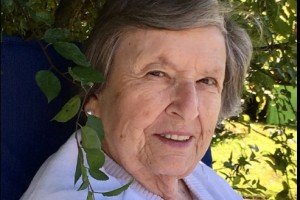Inge was born in Hamburg in 1928 of non-practicing Jewish parents. She had only one sibling, a sister Ilse, five years her senior. They lived in what was considered the red light district of Hamburg, an area near the docks, where her father had established a medical practice. He had become a well respected and popular physician. Although Jewish, her father had no interest in religious practice. Her mother was half Jewish but her maternal family had adopted Protestantism.
Inge and her sister attended a small school in this area until Hitler started closing local schools down. Following this closure, Inge and many other children were instead being taught in what were family home settings. Also, at this time her father was no longer being allowed to work as a physician, so their main source of income was jeopardized.
In 1938, Inge was 10 years old when on November 9th the terror known as “Kristallnacht” (the Night of Broken Glass) besieged Jewish-owned properties. Someone had managed to warn her parents just prior to that night, so they managed to flee the family home.
Previous to this, her parents had been told of a secure evacuation process established by the British called Kindertransport. Through the auspices of this organization, Inge’s older sister left on a ship for England. Shortly, thereafter, Inge was taken by train via Holland and ultimately arrived in Liverpool. (Inge remembers that in the Netherlands, Queen Wilhelmina greeted the children from this train and provided them with lemonade).
When the girls left Germany, there had been no discussion as to when their family would ever reunite. The girls found later that their parents had died apart, in different concentration camps.
In Liverpool, Inge (with her name tag attached) was one of several children picked up by strangers who had previously offered their homes. She was taken by ferry to Ulster in Northern Ireland to a boarding home run by two elderly ladies. Here, she was finally reunited with her sister. These two women provided food and lodging but were very strict in their care. They were staunch Methodists and required all the children in their home to attend religious services every day and twice on Sunday.
They had arrived in this small community of Bangor just three weeks before the Second World War actually began. Inge has memories of the kindness of the teachers in that village school, enjoying her school experience more than life in the boarding house.
Because of the war, the entire school had to be evacuated to a more remote area of Ulster. As this school taught children only to age 17, Ilse had left at that age to attend Queens University in Belfast. There was a Jewish refugee committee in Ireland at that time; through their auspices, Inge was also able to attend Queens University. Her interest was to work in the field of community care. Inge graduated in 1948 with a General Degree.
Inge found employment with the Housing Trust in the Ulster region. This involved working with families needing homes and following them to ensure the assigned housing was adequate and that the families were doing well. Her role included picking up their rent — but it was really an early version of social work. Before fully qualifying in this role, however, she was required take courses in subjects as diverse as accounting, legal matters, and surveying. Inge even had to be knowledgeable about plumbing!
After 7 years of this work, Inge wanted a change from Ulster so she applied and got a similar position in Tunbridge Wells in Kent. However, after two years here, she relocated to London where she took a 3-month secretarial course and found a job with a publishing firm. The company found, however, she was much more useful to them translating German articles. She even translated the book Heidi as part of her work.
Inge found herself under a lot of stress in that role, which affected her health. She was given an incorrect diagnosis of multiple sclerosis (a diagnosis that was later disproved in Canada).
In London, Inge met an Austrian engineer called Jascha. He encouraged her to come to Canada where he was going to work in the lumber field. They were married in 1959 and have two sons, David (who lives in Ontario) and Simon (who works at BCIT). Initially in Vancouver, Inge did some tutoring and other volunteer work until she earned her teaching certificate at Simon Fraser University. She was a substitute teacher for ages K-12 for two years, and then taught an adult upgrading program at a the vocational trade school associated with BCIT.
Inge and Jascha separated in the 1980’s. He chose to live in their place on Saltspring Island, while she remained in their family home in North Vancouver for 63 years so far. She has become the neighbourhood grandmother as she is close to two families with young children. One end of her dining room table is covered with kids toys for the benefit of her youngest visitors.
Inge is an artist known within the North Shore artistic community. She once held retrospective of 45 pieces of her work in our church.
Inge first found out about NSUC from Jewish friends in the Vancouver Church. In the days before we had a minister, she volunteered in the children’s program as well as helping with program development.
There’s no doubt Inge has made her contribution to our church, as well as to BC’s education system.

